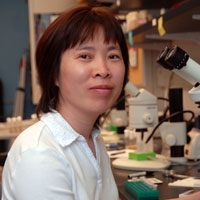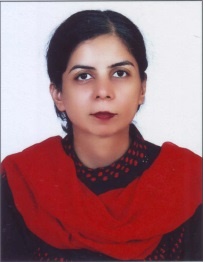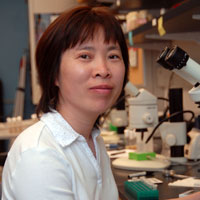Day 2 :
Keynote Forum
Hector Barajas-Martinez
Corporacion Genetica Global (Global Genetics Corporation), USA/MEXICO
Keynote: Gender effect on the genotype-phenotype correlation in congenital long QT syndrome
Time : 09:00-09:30

Biography:
Hector, Barajas-Martinez (PhD in Human Genetics and Fellow of Heart Rhythm Society) is currently the CEO of Global Genetics Corporation and Scientific Chief Officer (SCO) of CAMDIA MEDICAL LLC in Ventura, California. He is a new Special Section Editor of Electrocardiology and Genetics/Inherited Arrhythmia Disorders below to peer review Journal of Electrocardiology. He was a Clinical Director of Molecular Genetics/Research Scientist at Molecular Genetics & Experimental Cardiology, Masonic Medical Research Laboratory in Utica, New York USA. Over the last 20 years or more he has been fully committed to advancing translational research in the field of genetics in cardiac arrhythmias. His new role in the Molecular Genetics and Functional Genomics Programs is to establish new strategies for molecular genetic approaches to identified new genetic markers in Inherited Cardiac Death Syndromes, Neuronal and Cancer diseases. He played a key role in the discovery and characterization of more than 8 new genes related to Brugada, Early Repolarization, Short and Long QT Syndromes and Hypertrophic and Dilated Cardiomyopathies, which were published in top tier scientific journals. We are interested in helping to identify novel gene or multiple genes mutations linked to inherited cardiac, diabetes, obesity, cancer and neuropathology syndromes associated with ion channels and structural gene-diseases.
Abstract:
In long QT syndrome (LQTS), female shows a higher risk of a cardiac event compared with a male in previous studies. However, the real nature about the difference between male and female is still lacking. In this investigation, we sought to comprehensively compare the genotype-phenotype correlation between sexes in genotyped LQTS patients. We enrolled 603 congenital LQTS cases from 6 registered centers (65.8% females; 72.9% probands; average ages at diagnosis, 21.8±17.8 y/o). Participants provided written informed consent, and clinical characteristics were recorded. All patients underwent at least LQT1-3 gene screening. Seventeen reported LQTS and other inherited arrhythmia candidate genes were sequenced with next-generation sequencing (NGS) in 306 (51%) cases. Major cardiac events (MCE) were defined as (aborted) sudden cardiac death, and/or documented malignant arrhythmias. Cardiac symptom includes syncope and MCE. Multiple factors determined the QTc and repolarization reserve could affect the clinical manifestation and eventually predispose cardiac events in LQTS patients. The gender difference in QTc is probably caused by sex hormone, especially higher level of testosterone after puberty. During the menstrual cycle, pregnancy, postpartum period, or menopause, QTc and risk of cardiac events significantly fluctuate in females. Nevertheless, the effect of gender and its underlying genetic dominators on QTc and clinical consequences is still undetermined, and the type of genetic mutation may help to further distinguish the high-risk LQTS subgroups, especially in the female. Although our result is deduced from patients collected by multiple international centers, and it includes the largest Chinese and Mexican LQTS cohort by far, it may not be generalizable to LQTS of all ethnicities, because we have restricted access to Black or African. In conclusion, the present study systematically reports the gender differences of genotype-phenotype correlation in LQTS patients, which provides further guidance on risk stratification and precision intervention. Further studies are warranted to decipher the unique gender code and to improve outcomes of LQTS patients.
Keynote Forum
David I Smith
Mayo Clinic, USA
Keynote: Whole Genome sequencing to study the role of HPV integration in Oropharyngeal squamous cell carcinoma
Time : 09:30-10:00

Biography:
David I Smith is an expert on DNA sequencing and is the Chairman of the Technology Assessment Group for the Mayo Clinic Center for Individualized Medicine. His research focuses on the role that the common fragile sites play in cancer development. His group also studies the different ways that human papillomavirus plays in the development of different cancers. They have been using several whole genome sequencing strategies to study these two important questions.
Abstract:
High-risk variants of human papillomavirus (HPV) are the major causative factor in the development of cervical cancer. These viruses are also responsible for a number of other anogenital cancers and are increasingly involved in the development of a completely different cancer oropharyngeal squamous cell carcinoma (OPSCC). Unlike cervical cancer, however, OPSCC has other risk factors most notably smoking or other carcinogenic exposures. In an attempt to study how HPV might be involved in the development of OPSCC we have been using two different whole genome sequencing strategies to study the molecular alterations that occur during the development of HPV-positive OPSCCs. The first is mate-pair next-generation sequencing (MP-Seq) on the Illumina sequencing platform. The second is 30X whole genome sequencing on the BGI (Complete Genomics) sequencing platform. Using MP-Seq we have found that HPV integration into the human genome only occurs in 30% of HPVpositive OPSCCs, which is quite distinct from what is observed in cervical cancer. We have also found that there are instances where HPV has integrated into the human genome, but that there remains a high copy number of extrachromosomal HPV sequences present, something that is also not usually found in cervical cancer. Using 30X whole genome sequencing we have been attempting to characterize the structure at and around individual HPV integrations. We have also used this sequencing to study other alterations that occur throughout the genome of these OPSCCs. Our work reveals that HPV may be playing different roles in the development of different OPSCCs. This is an excellent model to study the earliest events in the development of cancer and how HPV facilitates carcinogenesis.
Keynote Forum
John Powers
Murrieta Genomics, USA
Keynote: Genomics the cellular evolution of Medicine
Time : 10:00-10:30

Biography:
John Powers has spent his entire professional career in high tech, first in the wireless industry and for the past 10 years, John has worked in the medical industry specifically focused on halting cancer. As CEO of IntraOp Medical, John worked with multidisciplinary teams including physicists, surgeons, radiation and medical oncologists in the top cancer centers around the world. Working with the Centers for Medicare & Medicaid Services (CMS) John was able to secure a new reimbursement code and reimbursement for Intra-Operative Radiation Therapy (IORT). John’s work with IntraOp led him to an interest in gene-based technologies available to foil cancer before a tumor can grow or metastasize. John has spent the past 3 years working with cancer and surgical centers promoting and expanding genetic and genomic testing. He is committed to the expansion and incorporation of gene sequencing in conventional medicine.
Abstract:
Statement of the problem: The current trajectory of health care costs is unsustainable without major changes. The lack of uniformity, true competition and focus on reimbursement as opposed to cost has greatly contributed to the out of control cost in current health systems. In addition, the number of doctors and medical professionals cannot keep pace with the growing demand. There are a number of other areas contributing as well, and the trajectory has to change. Healthcare “digitization” has been happening at all levels of the healthcare continuum and will provide the tools and understanding to move the medical industry to the health industry and allow the patient to take a more active part in determining their correct path. Enabling technology: Next Generation Technology (NGS) is an incredible enabling technology. It has the potential to impact medical the same was Code Division Multiple Access (CDMA) impacted the cellular market. Leading to unlimited calling plans and an explosion of data applications. NGS will help drive new cost milestones due to the volume and quality of information that can be derived from a single NGS test. DNA, RNA, Microbiome, epigenetics, and other comics. NGS driven testing is already having positive impacts on diagnosis, pain management, nutrition, imaging, treatment planning, radiation therapy, chemotherapy, surgery, and surveillance. This is not a comprehensive list but provides an idea of the vast amount of data NGS can produce. Conclusion: Just like in the cellular communications market, the applications, software, and applications will evolve over the next decade to fully utilize the power of NGS. The medical market is looking at neural networks, deep learning, and artificial evolution programming. These two industries are going to continue to converge as part of medical evolution.
Keynote Forum
Genhua Pan
University of Plymouth, UK
Keynote: Graphene biosensors for label-free detection of blood-based biomarkers for Alzheimer’s disease
Time : 10:50-11:20

Biography:
Genhua Pan is a Professor and Head of Wolfson Nanomaterials & Devices Laboratory at the University of Plymouth, UK and Coordinator of EU H2020 Marie Curie network BBDiag. He has over 30 years of research and teaching experience in micro/nanoscale thin films and devices, information storage technology and electronic engineering. His current research interest encompasses graphene & 2D materials/devices, biosensors, renewable energy/solar cells, spintronics and magnetic data storage. Genhua graduated from Zhejiang University, China in 1981, worked in the Chinese Academy of Science until 1988 when he obtained a scholarship to visit Loughborough University for a year. He then joined Plymouth University in 1989, gained my PhD in materials and physics in 1993. Over the years, He has also worked with a number of institutions as a visiting researcher (Sony Research Centre, Yokohama, Japan, Akita Institute of Technology, Akita, Japan, and Seagate Technology, Northern Island). To date, he has published over 100 journal and conference papers, 3 book chapters and 6 patents.
Abstract:
Statement of the Problem: Alzheimer’s disease is the most common form of dementia leading to a massive irreversible neuronal loss and cognitive decline. It affects over 7 million people in Europe and 5.5 million in America and this figure is expected to double every 20 years as the population ages. Early detection of the AD is the key requirement for developing disease-modifying treatments as studies show that pathology exceeds symptom by years. The existing techniques for detection using CSF and Imaging biomarkers are highly expensive and invasive. Blood-based biomarkers, however, can provide a simple and effective way for the screening of AD patients. The talk covers the latest progress in the EU H2020 BBDiag research project, for the development of blood biomarker-based diagnostics for early-stage AD employing by multiplexed graphene biosensor arrays. Methodology & Theoretical Orientation: Two novel graphene biosensors were developed for label-free detection of DNA and protein biomarkers, a graphene immunoFET for detection of protein markers and a rGO-graphene electrode for detection of DNA markers. Findings: The rGO electrode shows enhanced redox current up to 40% higher in comparison with electrodes of bare graphene due to the combination of a high number of electroactive sites on rGO and high conductivity of pristine graphene. A linear range from 10-7M to 10-12M is demonstrated for the biosensor with a detection limit of 1.58 x 10-13M. The immunoFET showed a unique resistance change pattern with high reproducibility and an ultralow detection limit of 1pg mL-1 and high sensitivity of 0.30 Ω/ng/mL. Conclusion & Significance: We have demonstrated that graphene biosensors can be employed for ultra-sensitive and label-free detection of DNA and proteomic disease biomarkers. The work may lead to the development of cost-effective and minimally invasive point of care diagnostic devices for routine screening of Alzheimer’s disease with a panel of biomarkers. Biography
Keynote Forum
Ron L Martin
Nutrigenetics Unlimited Inc., USA
Keynote: Genetics/Genomics for both treatment and prevention: The evidence-base
Time : 11:20-11:50

Biography:
Ron Martin received his BS and MS degrees in Food Science and Nutrition from Chapman University, in Orange, California. He worked for more than 35 years in the nutraceutical and food industries, including Hunt-Wesson/ConAgra, Plus Products, the William. T. Thompson Co., and the Nutrilite division of Alticor, where he served as Senior Research Scientist in Nutrilite's New Concepts group. Ron has been a Professional member of the Institute of Food Technologists (IFT) and is President of Nutrigenetics Unlimited, Inc., which he founded in 2007 (www.Nutrigenetics.net). He is also one of the founding members of the International Society of Nutrigenetics/Nutrigenomics (ISNN, www.NutritionAndGenetics.org).
Abstract:
The emerging genetics/genomics evidence-base for both treatments and prevention will be described, along with online tools for increasing both awareness and utility of the increasingly actionable information. This can be helpful to the entire spectrum of potential users, including students and other members of the public. Such tools are increasingly important as the body of literature continues to expand rapidly, making it progressively more difficult to identify and manage the evidence-base for making genetics-informed choices. Online resources will be described, including the use of standardized terminology which allows the creation of subtopic listings for any given topic, or for any given combination of topics – including for genes and gene variants. Beyond diagnosis and treatment alone, such approaches also allow identification and exploration of prevention opportunities (both embracement and avoidance). Such information can be useful for pursuing both physical and mental health. Gene-environment examples include nutrition, pharmaceuticals, pollution, lifestyle, social environment, etc. Because nutrition applies to everyone without exception, it can become a useful introductory "archetype" for promoting greater engagement, and greater genetics/health literacy.
Keynote Forum
Dr. David I Smith
Department of Laboratory Medicine and Pathology,Mayo Clinic,USA
Keynote: Whole Genome Sequencing Strategies to Characterize Human Papillomaviruses Role in the Development of Cancer

Biography:
David I Smith is the Chairman of the Technology Assessment Group for the Mayo Clinic Center for Individualized Medicine. He is an expert of advanced DNA sequencing methodologies and how to use these to study the molecular alterations that occur during cancer development. His research focuses on the different roles that human papillomavirus plays in the development of different cancers. His group also studies genome instability during cancer development and the role that the common fragile sites plays in this.
Abstract:
Human papillomavirus (HPV) is involved in the development of a number of anogenital cancers and is increasingly involved in the development of oropharyngeal squamous cell carcinoma (OPSCC), a cancer of the base of the tongue and the thyroid. Much of what is currently known about HPVs role in cancer development comes from studies of cervical cancer. Women whole immune system does not clear the HPV virus are at an increased risk of developing cervical cancer. Infection of the cervical epithelium with HPV causes cellular immortalization but additional alterations are required for invasive cancer to develop. One such alteration in integration of the HPV virus into the human genome which is observed in most, but not all, cervical cancers. We have been studying HPVs role in the development of OPSCC using several whole genome sequencing strategies. The first is mate pair next generation sequencing on the Illumina sequencing platform. The second is whole genome sequencing (WGS) on the BGI sequencing platform. These studies have revealed that HPVs role in the development of OPSCC is different that in cervical cancer as HPV is only integrated in about 30% of HPV-positive OPSCCs. Furthermore these studies have demonstrated that HPV plays different roles in the development of different OPSCCs. WGS not only can determine where HPV has integrated into the human genome but also the structure of the chromosomal region after the integration event. WGS can also characterize many other genomic alterations that occur in these cancer genomes. I will describe our work characterizing how we’ve utilized genome sequencing to study HPVs role in the development of OPSCC.
Keynote Forum
Krishna Dronamraju
Foundation for Genetic Research, President of the Foundation for Genetic Research,USA
Keynote: Genomics and ELSI (ethical, legal, and social issues)

Biography:
Dr. Krishna Dronamraju is President of the Foundation for Genetic Research in Houston and a Visiting Professor of the University of Paris. He is the author of 20 books in Genetics, Biotechnology and History of Science. He had been an Advisor to the U.S. Government in Genetics and Biotechnology in relation to Health and Agriculture. His research interests include the ethical and social impact of genetic applications, human gene therapy, and history of genetics.
Abstract:
J.B.S. Haldane (1923) was the first to emphasize the ethical impact of Genomics. Gene-based diagnostics and therapeutics are being widely integrated into healthcare today. However, there are barriers to accessing these new technologies for the public worldwide. An important role for all nurses will be to make sure that the health and social needs of the public are being met, including addressing the technological inequities in accessing genomic health care worldwide. This requires a major shift in emphasis to a more global view of health and disease.
The basis for equal access to genomic health care around the world can be found in the World Health Organization’s Proposed Guidelines on Ethical Issues in Medical Genetics and Genetics Services. The core public health function of assurance includes making sure that the general public has access to and quality of genomic healthcare, and informing populations about relevant genomic health issues and services. The World Health Organization document emphasizes the importance of education about genetics for the public and all healthcare professionals noting the profound economic and technological inequities that exist between nations.
Governmental agencies can assist in promoting genetic and genomic healthcare around the world. In the United States, the Centers for Disease Control and Prevention (CDC) has taken a leading role in addressing issues of access to genetic and genomic resources by creating multiple tools and resources that address the role of genetics in public health. Health care workers can take a leading role working with state, federal, and international health agencies to provide guidance to health systems with regard to decisions about utilization of genetics and genomics services. The opportunities to fully participate in genomic healthcare throughout the healthcare continuum, for all populations, and at all stages in the lifespan are multiple. The challenge is to ensure that the workforce is prepared and competent to provide genetic and genomic care. Knowledge and understanding of current and emerging ethical issues is an essential component of this knowledge base.
Keynote Forum
John Powers
Co-Founder at Murrieta Genomics,USA
Keynote: Genomics the Cellular Evolution of Medicine

Biography:
John Powers has spent his entire professional career in high tech, first in the wireless industry and for the past 10 years, John has worked in the medical industry specifically focused on halting cancer. As CEO of IntraOp Medical, John worked with multidisciplinary teams including physicists, surgeons, radiation and medical oncologists in the top cancer centers around the world. Working with the Centers for Medicare & Medicaid Services (CMS) John was able to secure a new reimbursement code and reimbursement for Intra-Operative Radiation Therapy (IORT). John’s work with IntraOp led him to an interest in gene-based technologies available to foil cancer, before a tumor can grow or metastasize. John has spent the past 3 years working with cancer and surgical centers promoting and expanding genetic and genomic testing. He is committed to the expansion and incorporation of gene sequencing in conventional medicine.
Abstract:
Statement of the problem: The current trajectory of healthcare costs is unsustainable without major changes. The lack of uniformity, true competition and focus on reimbursement as opposed to cost has greatly contributed to the out of control cost in current health systems. In addition, the number of doctors and medical professionals cannot keep pace with the growing demand. There are a number of other areas contributing as well, and the trajectory has to change. Healthcare “digitization” has been happening at all levels of the healthcare continuum and will provide the tools and understanding to move the medical industry to the health industry and allow the patient to take a more active part in determining their correct path.
Enabling technology: Next Generation Technology (NGS) is an incredible enabling technology. It has the potential to impact medical the same was Code Division Multiple Access (CDMA) impacted the cellular market. Leading to unlimited calling plans and an explosion of data applications. NGS will help drive new cost milestones due to the volume and quality of information that can be derived from a single NGS test. DNA, RNA, Microbiome, epigenetics, and other omics. NGS driven testing is already having positive impacts in diagnosis, pain management, nutrition, imaging, treatment planning, radiation therapy, chemotherapy, surgery, and surveillance. This is not a comprehensive list, but provides an idea of the vast amount of data NGS can produce.
Conclusion: Just like in the cellular communications market, the applications, software and applications will evolve over the next decade to fully utilize the power of NGS. The medical market is looking to neural networks, deep learning and artificial evolution programming. These two industries are going to continue to converge as part of medical evolution.
- Human Genetics | Cancer Genetics | Genetic Disorders | Molecular and Cellular Genetics | Medical Genetics | Population and Evolutionary Genetics | Cytogenetics | Epigenetics | Immunogenetics | Pharmacogenomics | Microbial Genomics | Cancer Genomics | Functional Genomics | Nutrigenomics
Session Introduction
Khushnooda Ramzan
King Faisal Specialist Hospital and Research Centre, Saudi Arabia
Title: Challenges and rewards of Usher syndrome genetics research in Saudi Arabia
Time : 13:50-14:15

Biography:
Abstract:
Change L Tan
University of Missouri, USA
Title: Holistic studies of whole genomes
Time : 11:50-12:15

Biography:
Change Tan received a BS in Chemistry at Hunan Normal University, an MS in organic chemistry at Nan Kai University, a PhD in biochemistry at University of Pennsylvania and a postdoc training in genetics at Harvard Medical School. She joined University of Missouri in 2005 and is currently an associate professor in the Division of Biological Sciences at University of Missouri. Her research interests include genetics, comparative genomics, developmental biology, molecular biology, origin of life, and origin of biodiversity. She teaches molecular biology and signal transduction to graduate and undergraduate students.
Abstract:
Sadia Ajaz
University of Karachi, Pakistan
Title: Germ-line mutanome profiling of the Breast cancers in Pakistani population
Time : 12:15-12:40

Biography:
Abstract:
Reina Villareal
Bayer college of Medicine, USA
Title: Musculoskeletal response to hormonal therapies is influenced by CYP19A1
Time : 13:40-14:05

Biography:
Abstract:
Reina Villareal
Bayer college of Medicine, USA
Title: Musculoskeletal response to hormonal therapies is influenced by CYP19A1

Biography:
Abstract:
Polymorphisms of the CYP191A1 which encodes aromatase, the enzyme that converts testosterone to estradiol, are reported to influence the skeletal phenotypes in both men and postmenopausal women. We reported that the rs700518 polymorphism (G to A) of the CYP19A1 was associated with differences in bone loss and body composition changes among women with estrogen receptor positive breast cancer given aromatase inhibitors (AIs). Women with the AA genotype had significant bone loss in the spine and total hip compared to women with the G allele (GA+GG genotypes) after 1-year AI treatment. Meanwhile, women with the GG genotype had significant loss in fat-free mass (FFM) and gain in trunk fat mass (TFM) compared to women with the A allele (AA+GA) who had no loss in FFM but had significant loss in TFM. These findings suggest that women with the GA genotype have the best side effect profile to AIs. Using the same concept in hypogonadal men treated with testosterone for 18 months shows that although there were no inter-genotype differences in bone mineral density changes (hip and spine) for both rs700518 and rs1062033, the GG genotype (G to C) for rs1062033 experienced significant improvement in bone geometry parameters (total bone and cortical area) compared to GC+CC genotypes. Moreover, total fat and TFM decreased more in AA than GA+GG and in CC than GC+GG in rs700518 and rs1062033, respectively. Lean mass increased more in AA than GA+GG and in CC than GC+GG in rs700518 and rs1062033, respectively. We found no intergenotype differences in adverse effects on the hematocrit and the prostate. A difference in CYP19A1 expression in the fat was observed in rs1062033 variants. Rs700518 and rs1062033 are in partial linkage in our sample. Thus, we conclude that CYP19A1 polymorphisms influences response to hormonal therapies and should be considered in treatment decision-making.
Diptee A. Kulkarni
Glaxo Smith Kline Research and Development, USA
Title: Identification of novel cancer target genes by combining data from the cancer genome wide association studies (GWAS), regulatory DNA elements and The Cancer Genome Atlas (TCGA)
Time : 14:05-14:30

Biography:
Abstract:
Anna R Moore
Temple University Philadelphia, USA
Title: Molecular regulation of experience dependent plasticity
Time : 14:30-14:55

Biography:
Abstract:

Biography:
Change Tan received a BS in Chemistry at Hunan Normal University, an MS in organic chemistry at Nan Kai University, a PhD in biochemistry at University of Pennsylvania and a postdoc training in genetics at Harvard Medical School. She joined University of Missouri in 2005 and is currently an associate professor in the Division of Biological Sciences at University of Missouri. Her research interests include genetics, comparative genomics, developmental biology, molecular biology, origin of life, and origin of biodiversity. She teaches molecular biology and signal transduction to graduate and undergraduate students.
Abstract:
- Poster presentations
Session Introduction
Adriana Pérez Portilla
National Centre for Biotechnology, Spain. Instituto de Investigación Sanitaria Puerta de Hierro Segovia de Arana, Spain
Title: Characterization of Genetic variation in the Fc gamma receptor locus in the Ecuadorian population
Biography:
Abstract:
Sharareh Kamfar
Hamadan University, Iran. National Institute for Genetic Engineering and Biotechnology, Iran and Baqiyatallah El - Azam Subspeciality Hospital, Iran
Title: Mitochondrial DNA copy number variation in Iranian patients with non-alcoholic fatty liver disease
Biography:
Abstract:
Kambiz Hasrak
Baqiyatallah El - Azam Hospital, Iran
Title: Analysis of mitochondrial DNA D-loop region mutations in Iranian patients with non-alcoholic fatty liver disease
Biography:
Abstract:
Guangying Wang
Chinese Academy of Sciences, China Zhejiang Gongshang University, China
Title: Toxicogenomic investigation of Tetrahymena thermophila exposed to organic pollutants and arsenic
Biography:
Abstract:
Gulmira Yermakhanova
Medical Center Hospital of President’s Affairs Administration, Republic of Kazakhstan
Title: Study of association of some gene polymorphisms with metabolic syndrome and its components in Kazakh population
Biography:
Abstract:
Massimiliano Chetta
Laboratory of Human genetics, ospedale Antonio Cardarelli, Italy and Department of Medicine, Surgery and Dentistry, University of Salerno, Italy







